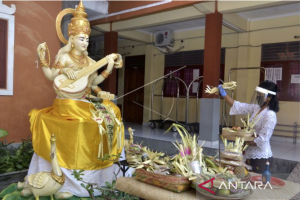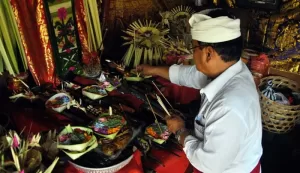Balinese Culture, a land renowned for its natural beauty, possesses an equally fascinating cultural heritage. This island has long been a preferred destination for travelers from around the world, offering much more than beautiful beaches and breathtaking natural landscapes. What makes Bali so captivating is the richness and diversity of its culture. In this article, we will explore seven unique and interesting traditional ceremonies in Bali.
1.The Melasti Ceremony

The Melasti ceremony is one aspect of Balinese culture that takes the form of a sacred ritual within the tradition of Hinduism in Indonesia, primarily on the island of Bali. Typically, this ceremony takes place a few days before Nyepi, which marks the beginning of the year in the Hindu calendar. The main purpose of Melasti is to purify and sanctify all religious items and temples from sins and negative influences. During this ceremony, Hindu devotees gather on the beach or near a river, bringing statues of gods, sculptures, and other offerings into the water for a purification process. Seawater or river water is considered to have spiritual power to cleanse all impurities, making Melasti a crucial moment for maintaining purity and harmony in the Hindu faith in Bali.
During the Melasti ceremony, Hindu devotees wear all-white clothing and recite sacred mantras while offering flowers, fruits, and perfumes to the gods. This ceremony serves not only to pay homage to nature and the environment but also to demonstrate the unity and diversity of Balinese society in preserving their religious tradition. Melasti reflects the deep spiritual values of Balinese Hindu culture and is one of the most fascinating events for visitors interested in witnessing it, often becoming a captivating tourist attraction.
2.The Galungan Ceremony

The Galungan Ceremony is one of the most significant and festive Hindu religious celebrations in Bali, Indonesia. This ceremony is observed by the Balinese Hindu community every six months to honor ancestral spirits and commemorate the victory of dharma (good) over adharma (evil) in Hindu mythology. One distinctive feature of Galungan is the installation of penjor, bamboo poles adorned with flowers, fruits, and leaves, in front of homes as a symbol of happiness and blessings. During the Galungan Ceremony, Balinese Hindus also wear elaborate clothing and pray at Hindu temples while offering sacrifices to their ancestors. This ceremony reflects the deep spiritual and cultural aspects of communal life in Bali.
On this day, families come together to celebrate, enjoying typical Balinese dishes like ayam betutu and lawar while visiting temples. Additionally, during Galungan, Balinese Culture Hindus make pilgrimages to the graves of their ancestors to offer sacrifices and prayers. This ceremony creates a sense of unity and solidarity within Balinese society, strengthening family and spiritual bonds.
3.The Ngaben Ceremony (Cremation)

Ngaben is one of the cremation ceremonies in the Hindu tradition in Bali, Indonesia. This ceremony holds great significance in Balinese Culture, where the deceased is prepared and then cremated in an elaborate ritual. The Ngaben process typically begins with the purification of the deceased’s body and its transfer to a receptacle called “lembu,” made from bamboo and other natural materials. This lembu is then carried in a festive procession before being cremated in a special ritual. Ngaben is seen as a way to release the soul of the deceased from their physical body and guide it to the spiritual realm, allowing for the start of a new cycle of life.
Apart from its spiritual aspect, Ngaben holds significant social importance as the Balinese community comes together to support the grieving family. This ceremony is often organized with grand celebrations involving many members of the local community. Ngaben illustrates the strong connection between religion, culture, and everyday life in Bali while demonstrating deep respect for ancestors and ancestral traditions.
4.The Makare-kare Ceremony

La cérémonie Makare-kare est une tradition culturelle très distinctive à Bali, en Indonésie. Cette cérémonie fait partie des célébrations de Tumpek Landep, organisées pour honorer les armes traditionnelles balinaises, telles que le kris. L’un des éléments les plus remarquables de la cérémonie Makare-kare est la représentation de combats d’ours, où deux ourses dressées se battent l’une contre l’autre sur le sable pendant plusieurs minutes. Cette représentation raconte l’histoire légendaire de Dewa Rambut Sedana qui se transforme en ours et doit combattre ses frères pour mettre fin à une malédiction. Cette cérémonie offre non seulement un spectacle divertissant pour les spectateurs, mais elle possède également une signification spirituelle et symbolique profonde dans la culture balinaise, reflétant la lutte entre le bien et le mal.
5.The Saraswati Ceremony

source : Antaranews.com
Balinese Culture is one of the most important and festive Hindu religious ceremonies in Bali, Indonesia. This ceremony is celebrated by Balinese Hindus every six months to honor ancestral spirits and to commemorate the victory of dharma (good) over adharma (evil) in Hindu mythology. One distinctive feature of Galungan is the installation of penjors, bamboo poles adorned with various flowers, fruits, and leaves, in front of homes as a symbol of happiness and blessings. During the Galungan Ceremony, Balinese Hindus also wear elaborate clothing, pray at Hindu temples (pura-pura), and offer offerings to their ancestors. This ceremony reflects the depth of spirituality and culture in the lives of the Balinese community.
Today, families gather to celebrate together, enjoying typical Balinese dishes such as chicken betutu and lawar while praying at temples. Additionally, during Galungan, Balinese Culture Hindus also make pilgrimages to the graves of their ancestors to offer sacrifices and prayers. This ceremony creates a sense of community and unity in Balinese society, where they support each other and strengthen their family and spiritual bonds.
6.The Tumpek Landep Ceremony

The Tumpek Landep Ceremony is one of the significant religious ceremonies in the Hindu tradition in Bali, Indonesia. This ceremony takes place every 210 days according to the Balinese Culture Hindu calendar and aims to pay homage to Dewa Sang Hyang Pasupati, considered the guardian of safety and protection energy. During the Tumpek Landep Ceremony, Balinese Hindus take various traditional tools such as sharp weapons, agricultural tools, musical instruments, and vehicles, then clean, decorate, and offer them in sacrifice to the gods as a sign of gratitude for their role in maintaining well-being and daily security.
This ceremony also conveys a profound spiritual message, teaching values such as courage, honesty, and balance in life. In addition to its religious aspect, Tumpek Landep is also an opportunity for Balinese society to come together as families and neighbors in a spirit of solidarity. This ceremony reflects the cultural richness and local wisdom that maintain close ties between humans, nature, and spirituality in daily life in Bali.
7.The Metatah Ceremony / The Tooth Filing Ceremony

The tooth filing ceremony, known as “metatah” in Balinese Culture, is an important religious ceremony in the Hindu culture of Bali. This ceremony is typically performed when a child reaches adulthood, usually between seven and ten years old. The main purpose of this ceremony is to purify the child from negative traits and sins that may have accumulated during their childhood.
During the tooth filing ceremony, a priest or temple guardian files the child’s canines with a special tool called a “keris.” The filing of the canines is seen as a symbol of removing animalistic traits and negative tendencies from the child, while strengthening their identity as an adult member of Balinese culture. This ceremony is usually followed by prayers, religious offerings, and other symbolic acts related to the child’s spiritual purification. The tooth filing ceremony is a significant moment in a child’s life in Bali and is an integral part of the island’s Hindu religious and cultural tradition.
Conclusion
The rich and diverse Balinese Culture is reflected through the many traditional ceremonies that take place on the island. From the purity of the Melasti Ceremony to the honoring of ancestors in the Ngaben Ceremony, each ceremony has a unique meaning and purpose. These ceremonies are also an essential part of daily life for the Balinese community, making it a particularly special culture.
By understanding and respecting these ceremonies, we can better appreciate the rich culture of Bali. Each ceremony offers an opportunity to understand the underlying values and beliefs while experiencing the spiritual and artistic beauty that is an integral part of Balinese life.
Enjoy your time in Bali with BaliEthnik, not only to appreciate its beautiful beaches but also to discover the wonderful Balinese culture that permeates every aspect of this island.




